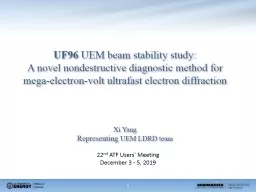

A novel nondestructive diagnostic method for megaelectronvolt ultrafast electron diffraction Xi Yang Representing UEM LDRD team 22 nd ATF Users Meeting December 3 5 2019 NSLSII ID: 912462
Download Presentation The PPT/PDF document "UF96 UEM beam stability study:" is the property of its rightful owner. Permission is granted to download and print the materials on this web site for personal, non-commercial use only, and to display it on your personal computer provided you do not modify the materials and that you retain all copyright notices contained in the materials. By downloading content from our website, you accept the terms of this agreement.
Slide1
UF96 UEM beam stability study:A novel nondestructive diagnostic method for mega-electron-volt ultrafast electron diffractionXi Yang Representing UEM LDRD team
22
nd
ATF Users’ Meeting
December 3 - 5, 2019
Slide2NSLS-IID. Bergman, L. Doom, M Fulkerson, G. Ganetis, Y. Hidaka, B. Kosciuk, D. Padrazo, T. Shaftan, V. Smalyuk, C. Spataro, X. Yang, J. Rose, G. Wang, K. Wilson, L. H. Yu, etc. ATFM. Fedurin, M. Babzien, R. Malone, k. Kusche, C. Cullen, etc.CMPMSDJ. Li, L. Wu, Y. Zhu, etc.ShanghaiTech University W. WanUEM LDRD participants
Slide3Motivation: Feasibility study of LDRD for UEM (ID: 305506, UED)A novel method of beam diagnostics: Bragg-diffractionExperimental resultsConclusionOutline
3
Slide4Schematic layout of the UED beamline
4
Beam
Slide5The UEM resolution for the proof-of-principle experiment is <200nm, dominated by chromatic aberration.The energy jitter will limit the UEM performance in the low-charge accumulation mode.Single-shot resolution of the UEM system will be limited by the energy spread at the required charge.Motivation
5
Slide6Develop a real-time nondestructive diagnostic method for UED (also applicable to UEM by changing the setting of the lenses to image the diffraction pattern) Idea of BDM: The information of the electron beam energy, energy fluctuation and spatial-pointing jitter is intrinsically encoded to the shot-to-shot diffraction image. Without perturbing the ongoing experiment, one can simultaneously measure the shot-to-shot energy fluctuation and spatial-pointing jitter of the electron beam via eigen-decomposing the variation of diffraction patterns to two decoupled modes:1st
mode: distance between Bragg peaks as well as its variation (radial mode): beam energy fluctuation.2nd mode: overall lateral shift of the whole pattern (drift mode): spatial-pointing jitter. Bragg-diffraction method
6
Slide7Develop a real-time nondestructive diagnostic method for UED (also applicable to UEM by changing the setting of the lenses to image the diffraction pattern) Idea of BDM: The shot-to-shot diffraction images intrinsically contain the following information about electron beam:Mean energyEnergy spreadShot-to-shot energy fluctuation Shot-to-shot spatial-pointing jitter
Without perturbing the ongoing experiment, one can simultaneously measure these electron beam parameters via eigen-decomposing the variation of diffraction patterns to two decoupled modes:Radial mode: distance between Bragg peaks as well as its variation: beam energy fluctuation.Drift mode: overall lateral shift of the whole pattern: spatial-pointing jitter. Bragg-diffraction method
7
Slide8ExperimentOptimize the measurement precision Single-shot image in data analysis.Advance algorithm for peak finding.The separation between the peak pair ij (Dij
) is determined by Interplane distance d Distance between the sample and the detector LS2D Electron beam energy EThe measured separation can be used to calibrate the shot-to-shot energy jitter based on
8
Slide9The shot-to-shot energy variation measured at two different electron beam energies: 0.216% r.m.s. at the nominal energy E0 (green)0.239% r.m.s. at 1.06E0
(red)Experimental results9
(Vertical)
(Horizontal)
The measured shot-to-shot pointing jitter is about 10 µrad, both horizontal (a) and vertical (b), at two different electron beam energies:
E
0
and 1.06
E
0
Slide10Correlation of the pointing jitter and energy jitter.Beam energy spread measured by the BDM (red circles) and by direct beam size measurement (green triangles), compared to the Impact-T simulations (black squares). The horizontal error comes mainly from the laser power fluctuation. The vertical error is described in the text.Measurement of electron beam energy spread
10
η
y
≈ 0.01 m
Energy jitter (blue) and pointing jitter in y (orange)
vs
shot number.
Charge (pC)
dE
/E
0.05
0.0001
5
0.0100
Slide11Beam energy calibration with RF modulation
11Calibrate beam energy at different RF settingIntroducing RF modulation we can measure dispersion at detector with better precision.
Slide12We demonstrated a novel beam diagnostic methodBeam parameters measuredShot-by-shot energy jitter with 2·10-3Shot-by-shot spatial-pointing jitter 10 µradDispersion at the detectorEnergy spread of the electron beam with different charges
Potential applications:Real-time energy measurement enables the filtering process to remove off-energy shotsApplicable to the entire UED user community, in addition to the traditional electron beam diagnostics.Publication:Yang, X., et al. A novel nondestructive diagnostic method for mega-electron-volt ultrafast electron diffraction. Scientific Reports 9, 17223 (2019). Conclusion
12
Slide13Thank you